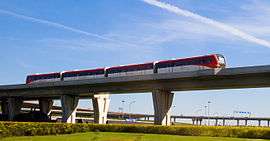Beijing Capital International Airport
| Beijing Capital International Airport 北京首都国际机场 | |||||||||||||||||||
|---|---|---|---|---|---|---|---|---|---|---|---|---|---|---|---|---|---|---|---|
 | |||||||||||||||||||
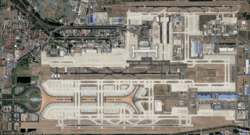 | |||||||||||||||||||
| Summary | |||||||||||||||||||
| Airport type | Public | ||||||||||||||||||
| Operator | Beijing Capital International Airport Company Limited | ||||||||||||||||||
| Serves | Beijing | ||||||||||||||||||
| Location | Chaoyang–Shunyi | ||||||||||||||||||
| Hub for | |||||||||||||||||||
| Focus city for | |||||||||||||||||||
| Elevation AMSL | 116 ft / 35 m | ||||||||||||||||||
| Coordinates | 40°04′21″N 116°35′51″E / 40.07250°N 116.59750°ECoordinates: 40°04′21″N 116°35′51″E / 40.07250°N 116.59750°E | ||||||||||||||||||
| Website |
en | ||||||||||||||||||
| Maps | |||||||||||||||||||
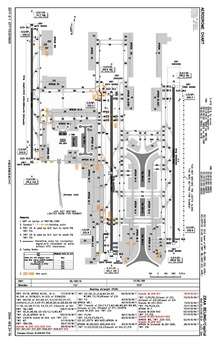 CAAC Airport Chart | |||||||||||||||||||
 PEK  PEK  PEK .svg.png) PEK | |||||||||||||||||||
| Runways | |||||||||||||||||||
| |||||||||||||||||||
| Statistics (2017) | |||||||||||||||||||
| |||||||||||||||||||
Beijing Capital International Airport (IATA: PEK, ICAO: ZBAA) is the main international airport serving Beijing. It is located 32 km (20 mi) northeast of Beijing's city center, in an enclave of Chaoyang District and the surroundings of that enclave in suburban Shunyi District.[4] The airport is owned and operated by the Beijing Capital International Airport Company Limited, a state-controlled company. The airport's IATA Airport code, PEK, is based on the city's former romanized name, Peking.
Beijing Capital has rapidly ascended in rankings of the world's busiest airports in the past decade. It had become the busiest airport in Asia in terms of passenger traffic and total traffic movements by 2009. It has been the world's second busiest airport in terms of passenger traffic since 2010. The airport registered 557,167 aircraft movements (take-offs and landings), ranking 6th in the world in 2012.[3] In terms of cargo traffic, Beijing airport has also witnessed rapid growth. By 2012, the airport had become the 13th busiest airport in the world by cargo traffic, registering 1,787,027 tons.[3]
History
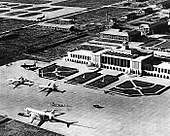

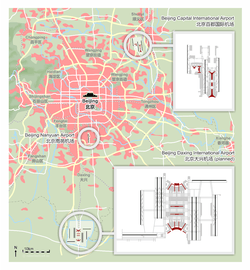
| Beijing Capital International Airport | |||||||||||||||||||
| Traditional Chinese | 北京首都國際機場 | ||||||||||||||||||
|---|---|---|---|---|---|---|---|---|---|---|---|---|---|---|---|---|---|---|---|
| Simplified Chinese | 北京首都国际机场 | ||||||||||||||||||
| |||||||||||||||||||
Beijing Airport was opened on 2 March 1958. The airport then consisted of one small terminal building, which still stands to this day, apparently for the use of VIPs and charter flights. On 1 January 1980, a newer, larger Terminal 1 – green in colour – opened, with docks for 10 to 12 aircraft. The terminal was larger than the one built in the 1950s, but by the mid-1990s, its size became relatively inadequate.
The first International flight to China and Beijing Capital International Airport was of Pakistan International Airlines from Islamabad.
In late 1999, to mark the 50th anniversary of the founding of the PRC, the airport experienced a new round of expansion as Terminal 2 opened on 1 November of that year. Terminal 1 was then temporarily closed for renovation after the opening of Terminal 2. 20 September 2004 saw the opening of a renovated Terminal 1, which at that time solely handled China Southern Airlines' domestic and international flights from Beijing.[5] Other airlines' domestic and international flights still operated in Terminal 2.
Another round of expansion started in 2007. A third runway opened on 29 October 2007, to relieve congestion on the other two runways.[6] Terminal 3 (T3) was completed in February 2008, in time for the Beijing Olympics. This colossal expansion also included a rail link to the city-center. At its opening, the new Terminal 3 was the largest man made structure in the world in terms of area covered, and a major landmark representing Beijing as the growing and developing Chinese capital. The expansion was largely funded by a 30 billion yen loan from Japan and a 500-million-euro (USD 625 million) loan from the European Investment Bank (EIB). The loan is the largest ever granted by the EIB in Asia; the agreement was signed during the eighth China-EU Summit held in September 2005.[7]
Fresh from hosting the 2008 Olympic Games and adding its new terminal building, Beijing Capital has overtaken Tokyo Haneda to be the busiest airport in Asia based on scheduled seat capacity.[8]
Due to limited capacity at Beijing Capital International Airport, a new airport in Daxing is being planned. The project was given final approval on 13 January 2013. Construction began in late 2014 and is expected to be completed in 2019.[9] It is not yet clear how flights will be divided between the two airports; a possible plan is that all airlines of the SkyTeam airline alliance are to move to the new airport.[10]
Terminals
The airport has three terminals. Terminal 1 serves the domestic routes of Hainan Airlines and its subsidiaries (while its international routes, plus flights to/from Hong Kong, Taiwan and Macau, operate from Terminal 2). Terminal 2 serves China Southern Airlines, China Eastern Airlines, SkyTeam (excluding Alitalia and China Airlines); in addition Oneworld members American Airlines and SriLankan Airlines, also other domestic and international flights. Terminal 3, the newest terminal, serves Air China, Star Alliance, Oneworld members (excluding American Airlines and SriLankan Airlines), plus Skyteam members- Alitalia and China Airlines, and some other domestic and international flights that do not operate from either Terminals 1 or 2.
Terminal 1
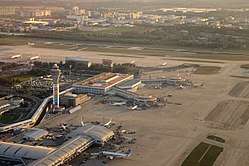
Terminal 1, with 60,000 m2 (650,000 sq ft) of space, opened on 1 January 1980, and replaced the smaller existing terminal, which had been in operation since 1958.[11] Terminal 1 was closed for renovation from 1 November 1999 to 20 September 2004, during which all airlines operated from Terminal 2. Featuring 16 gates, it was the operational base for the domestic routes of China Southern Airlines and a few other airlines such as Xiamen Airlines and Chongqing Airlines, and was originally planned to handle domestic traffic excluding those to Hong Kong and Macau.
With the opening of Terminal 3, the terminal was closed for light refurbishment, and its airlines were moved to Terminal 2 on 20 May 2008.[12] Terminal 1 reopened for a second time on 27 June 2008, and became the operational base for all domestic flights operated by the HNA Group including those of Hainan Airlines, Grand China Air, Beijing Capital Airlines and Tianjin Airlines, while all HNA Group's international flights as well as those to Hong Kong, Macau and Taiwan remain in Terminal 2.[13]

Terminal 2
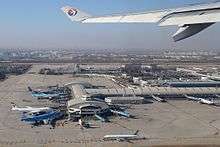
Terminal 2 opened on 1 November 1999, with a floor area of 336,000 m2 (3,620,000 sq ft).[11] This terminal was used to replace Terminal 1 while the latter was undergoing renovation, cramping all airlines despite being far bigger than Terminal 1. It can handle twenty aircraft at docks connecting directly to the terminal building. Prior to the opening of Terminal 3, all international flights (and the majority of the domestic flights) operated from this terminal. This terminal now houses China Eastern Airlines, China Southern Airlines, Hainan Airlines (all International flights including flights to Taiwan, Hong Kong, and Macau), SkyTeam (excluding China Airlines), Oneworld members -American Airlines and SriLankan Airlines, Air Koryo, and other domestic and international flights other than those operated by Air China, Shanghai Airlines, Star Alliance members and Oneworld members. A gate capable of handling the A380 (gate 21) was also built at the terminal.
Terminals 1 and 2 are linked by a public walkway that takes about 10–15 minutes to traverse. Shuttle buses connect all three terminals.
.jpg)

Terminal 3
.jpg)
Construction of Terminal 3 started on 28 March 2004, and the terminal opened in two stages. Trial operations commenced on 29 February 2008, when seven airlines including British Airways, El Al Israel Airlines, Qantas, Qatar Airways, Shandong Airlines and Sichuan Airlines moved into the terminal. Twenty other airlines followed when the terminal became fully operational on 26 March 2008.[14] Currently, it mainly houses Air China, Oneworld (excluding American Airlines and SriLankan Airlines), Star Alliance, Skyteam members-Alitalia and China Airlines,and other domestic and international flights that are not operated from Terminal 2. Star Alliance members LOT Polish Airlines, Scandinavian Airlines, Lufthansa, Austrian Airlines, United Airlines, Air Canada, Turkish Airlines, Thai Airways International, Singapore Airlines, All Nippon Airways, Asiana Airlines, and Air China use Terminal 3-E as part of the Move Under One Roof program to co-locate alliance members.
Terminal 3 was designed by a consortium of Netherlands Airport Consultants (NACO), UK Architect Foster and Partners and ARUP. Lighting was designed by UK lighting architects Speirs and Major Associates. The budget of the expansion is US$3.5 billion. Much larger in size and scale than the other two terminals, Terminal 3 was the largest airport terminal-building complex in the world to be built in a single phase, with 986,000 m2 (10,610,000 sq ft) in total floor area at its opening.[11] It features a main passenger terminal (Terminal 3C) and two satellite concourses (Terminal 3D and Terminal 3E), all of them five floors above ground and two underground, with the letters "A and B" omitted to avoid confusion with the existing Terminals 1 and 2. Only two concourses were initially opened, namely Terminal 3C dedicated for domestic flights and Terminal 3E for international flights. Terminal 3D officially opened on 18 April 2013. The newly opened concourse is temporarily used solely by Air China for some of its domestic flights.[15]
Terminal 3 of the BCIA is currently the second-largest airport passenger terminal building in the world. Its title as the world's largest was surrendered on 14 October 2008 to Dubai International Airport's Terminal 3, which has 1,713,000 m2 (18,440,000 sq ft) of floor space.
On 20 July 2013, a man in a wheelchair detonated small homemade explosives in Terminal 3 of the Beijing International Airport. The bomber, reported to be Ji Zhongxing, was injured and taken to a hospital for his injuries. No other people were hurt.[16][17]



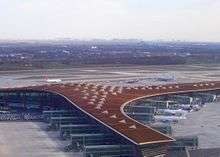
System, security and luggage

Terminal 3 has a 300,000 m2 (3,200,000 sq ft) transportation centre with a 7,000-car garage. The transportation centre has designated traffic lanes for airport buses, taxis and private vehicles. Travelers bound for T3 can exit their vehicles and enter T3 within five minutes. There is also a station for the Airport Express Line of the Beijing Subway.
Terminal 3 has 243 elevators, escalators or moving walkways. Each row of seats in the waiting area has electrical outlets. Every restroom has a diaper changing station. There is also a room for travelers with disabilities..
One of Terminal 3's highlights is the US$240 million luggage-transfer system. The luggage system is equipped with yellow carts, each of which has a code that matches the bar code on every piece of luggage loaded and allows easy and accurate tracking. More than 200 cameras are used to monitor activities in the luggage area.
The luggage system can handle 19,200 pieces of luggage per hour. After a luggage is checked in at any of the 292 counters in Terminal 3C, it can be transferred at a speed of ten metres per second. Hence, a luggage can travel from T3C to T3E in five minutes. Arriving passengers should be able to begin retrieving their luggage within 4.5 minutes after airplanes are unloaded.
Besides X-ray scanners, additional equipment are used to conduct baggage screening. Passengers will be able to check in their luggage at the airport from several hours to even a day before their flights. The airport will store the luggage in its luggage system and then load it on the correct aircraft.
Appearance
The highest building at the airport, A 98.3 m (323 ft) monitoring tower, stands at the southern end of T3. The roof of T3 is red, the Chinese color for good luck. The terminal's ceilings use white strips for decoration and to indicate directions. Under the white strips, the basic color of the ceiling is orange with light to dark tones indicating where a passenger is inside the building. The roof is light orange in the center. The color deepens as the roof extends to the sides in T3E and goes the other way round in T3C.
The roof of T3 has dozens of triangular windows to let in daylight. Light angles can be adjusted to ensure adequate interior lighting. Many traditional Chinese elements will be employed in the terminal's interior decoration, including a "Menhai", a big copper vat used to store water for fighting fires in the Forbidden City, and the carvings imitating the famous Nine-Dragon Wall.
An indoor garden is constructed in the T3E waiting area, in the style of imperial gardens such as the Summer Palace. In T3C, a tunnel landscape of an underground garden has been finished with plants on each side so that passengers can appreciate them inside the mini-train.
Facilities
The T3 food-service area is called a "global kitchen," where 72 stores provide food ranging from formal dishes to fast food, from Chinese to western, and from bakery goods to ice cream. Airport officials have promised that people who buy products at the airport will find the same prices in central Beijing.
In addition to food and beverage areas, there is a 16,200 m2 (174,000 sq ft) domestic retail area, a 12,600 m2 (136,000 sq ft) duty-free-store area and a nearly 7,200 m2 (78,000 sq ft) convenience-service area, which includes banks, business centres, Internet services and more. At 45,200 m2 (487,000 sq ft), the commercial area is twice the size of Beijing's Lufthansa Shopping Center.
The terminal provides 72 aerobridges or jetways and is further complemented with remote parking bays that bring the total number of gates to 150. Terminal 3 comes with an additional runway. It increases BCIA's total capacity by 72 million passengers per year to approximately 90 million.[18]
Airbus A380
The terminal has gates and a nearby runway that can handle the Airbus A380. This capability was proven when Singapore Airlines briefly offered A380 flights to Beijing in August 2008 during the Summer Olympics. Emirates Airline has started its scheduled daily operation to Dubai as of 1 August 2010. Lufthansa has been using these facilities since October 2010 to handle up to five A380 flights per week. Several other airlines in the near future will operate the A380 out of this terminal, including Malaysia Airlines and British Airways.
Airlines and destinations
Passenger
Cargo
Ground transportation
Intra-terminal transportation
| Beijing Capital International Airport Terminal 3 People Mover | |
|---|---|
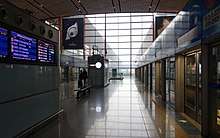 The people mover station at T3C | |
| Overview | |
| Owner | Beijing Capital International Airport Company Limited |
| Area served | Beijing Capital International Airport |
| Locale | Beijing, China |
| Transit type | People mover |
| Number of lines | 1 |
| Line number | 1 |
| Number of stations | 3 |
| Operation | |
| Began operation | March 2008 |
| Operator(s) | Bombardier Transportation |
| Character | Airside |
| Number of vehicles | 11 Bombardier Innovia APM 100 vehicles |
| Technical | |
| System length | 2.08 kilometres (1.29 mi) |
Terminal 3 consists of three sub-concourses. Both domestic and international travellers check in at concourse T3C. Gates for domestic flights (excluding those to Taiwan, Hong Kong, and Macau) are in T3C, and gates for domestic flights operated by Air China are also located in concourse T3D. All international flights, including those to Taiwan, Hong Kong, and Macau, are handled in concourse T3E.
In conjunction with the construction of the new terminal, Bombardier Transportation installed a 2 km (1.2 mi) automated people mover which connects T3C and T3E via T3D in a 2–5 minute one-way trip.[42] The line uses Innovia APM 100 vehicles running at 6-minute intervals at a maximum speed of 55 kilometres per hour (34 mph).[43]
Inter-terminal transportation
.jpg)
The airport provides a free inter-terminal shuttle bus between Terminals 1/2 and 3. They operate every 10 minutes from 6 am to 11 pm, and every 30 minutes from 11 pm till 6 am. Terminals 1 and 2 are connected by a lengthy corridor.
Rail
Beijing Capital International Airport is served by the Airport Express Line, a dedicated rail link operated as part of the Beijing Subway system. The 28.1 km (17.5 mi) line runs from Terminal 3 to Terminal 2 and then to the city with stops at Sanyuanqiao and Dongzhimen. The line opened on 19 July 2008, in time for the 2008 Olympics. A one-way trip takes approximately 16–20 minutes and costs ¥25. The running hours are 6:35-23:10 for T2, 6:20-22:50 for T3 and 6:00-22:30 for Dongzhimen.[44]

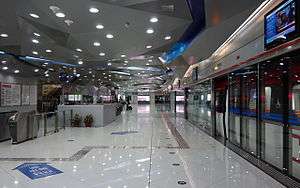
Bus
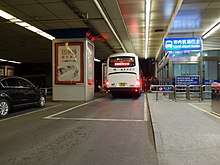
There are 18 bus routes to and from points throughout the city including Xidan, Beijing Railway Station, Beijing South Station, Beijing West Station, Zhongguancun, Fangzhuang and Shangdi. The airport buses run to each of the three terminals and cost up to ¥30 per ride depending on the route. The airport buses accept only paper tickets that are sold at each terminal and certain bus stops in the city. The airport also offers inter-city bus services to and from neighboring cities including Tianjin, Qinhuangdao, Baoding, Langfang and Tangshan.
Car
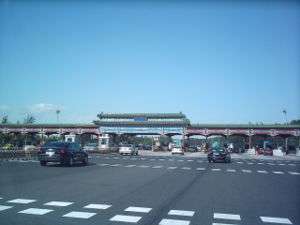
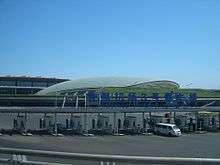
The airport is accessible by four express tollways. Two of these run directly from northeastern Beijing to the airport. The other two connect to the airport from nearby highways.
- The Airport Expressway is a 20 km (12 mi) toll road that runs from the northeastern 3rd Ring Road at Sanyuanqiao directly to Terminals 1 and 2. It was built in the 1990s and has served as the primary road connection to the city.
- The 2nd Airport Expressway, opened in 2008, is a 15.6 km (9.7 mi) toll road that runs east from Yaojiayuan Lu at the eastern 5th Ring Road and then north to Terminal 3.
- The Northern Airport Line, opened in 2006, is an 11.3 km (7.0 mi) toll road that runs east from the Jingcheng Expressway to Terminals 1 and 2.
- The Southern Airport Line, opened in 2008, is a toll road that runs parallel and to the south of the Northern Airport Line from the Jingcheng Expressway to the eastern Sixth Ring Road at the Litian Bridge. This highway crosses the Airport Expressway and 2nd Airport Expressway, and enables drivers on the former to reach Terminal 3 and the latter to head to Terminals 1 and 2.
Accolades
| Traffic | Rank | Year |
|---|---|---|
| List of airports by passenger traffic | 2 | 2014 |
| List of airports by traffic movements | 5 | 2014 |
| List of airports by cargo traffic | 12 | 2014 |
- 2009 – 1st on the ranking of the World's Best Airport by Condé Nast Traveler magazine, based on its satisfaction survey.[45]
- 2011 – 3rd Best Airport Worldwide of the Airport Service Quality Awards by Airports Council International.[46]
Statistics
| Passengers | Change from previous year | Movements | Cargo (tons) | |
|---|---|---|---|---|
| 2007[47] | 53,611,747 | 399,209 | 1,416,211.3 | |
| 2008[47] | 55,938,136 | 429,646 | 1,367,710.3 | |
| 2009[48] | 65,375,095 | 487,918 | 1,475,656.8 | |
| 2010[49] | 73,948,114 | 517,585 | 1,551,471.6 | |
| 2011[50] | 78,674,513 | 533,166 | 1,640,231.8 | |
| 2012[3] | 81,929,359 | 557,167 | 1,787,027 | |
| 2013[51] | 83,712,355 | 567,759 | 1,843,681 | |
| 2014[52] | 86,128,313 | 581,952 | 1,848,251 | |
| 2015 | 89,900,000 | 594,785 | 1,843,543 | |
| 2016 | 94,393,000 | 606,086 | 1,831,167 |
Other facilities
Beijing Capital Airlines has its headquarters in the Capital Airlines Building (首都航空大厦 Shǒudū Hángkōng Dàshà) at the airport.[53][54]
Sister airports
Photo gallery
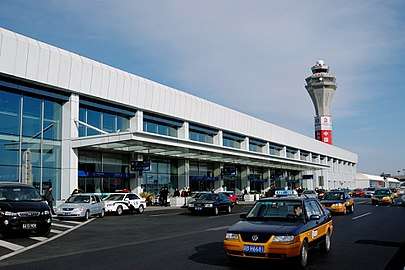 Curbside departure view of Terminal 1
Curbside departure view of Terminal 1 A Boeing 737 being serviced at Terminal 1
A Boeing 737 being serviced at Terminal 1- Departure Entrance of Terminal 1
 Entrance to Terminal 2
Entrance to Terminal 2 Terminal 2
Terminal 2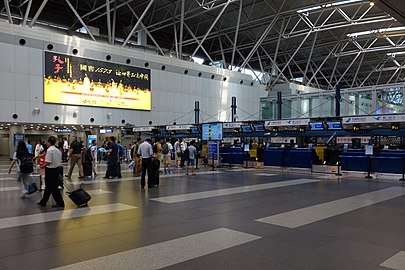 Terminal 2 Check-In
Terminal 2 Check-In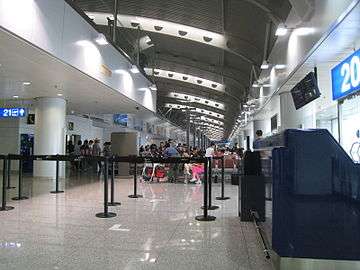 Terminal 2 Departure Waiting Hall
Terminal 2 Departure Waiting Hall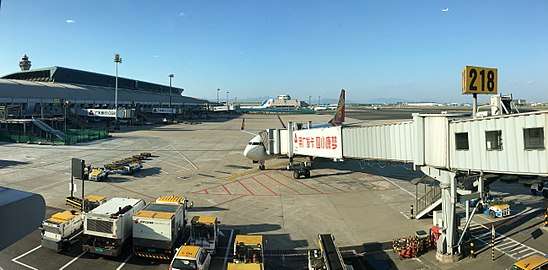 A Hainan Air Boeing 737 (foreground) at gate along with China Eastern and Xiamen Airlines aircraft parked at Terminal 2
A Hainan Air Boeing 737 (foreground) at gate along with China Eastern and Xiamen Airlines aircraft parked at Terminal 2.jpg) Curbside of departure level at Terminal 3
Curbside of departure level at Terminal 3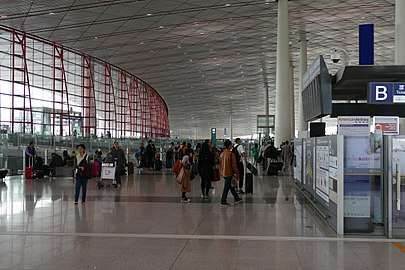 Terminal 3 Departure Enterance
Terminal 3 Departure Enterance Main hall of Terminal 3
Main hall of Terminal 3.jpg) Triangular roof of Terminal 3
Triangular roof of Terminal 3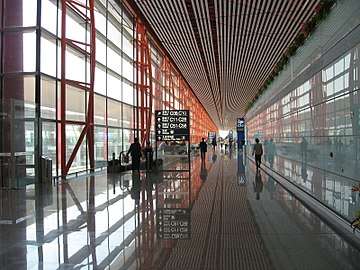 Sign displaying gate locations in Terminal 3 of PEK
Sign displaying gate locations in Terminal 3 of PEK- Hall in Terminal 3
See also
References
- ↑ Boeing.com Beijing Capital International Airport Archived 16 January 2013 at the Wayback Machine.
- ↑ "Beijing Capital International airport – Economic and social impact". Ecquants. Archived from the original on 24 May 2014. Retrieved 7 September 2013.
- 1 2 3 4 "31 March 2014 Preliminary world airport traffic and rankings 2013" (PDF). 31 March 2014. Retrieved 29 April 2014.
- ↑ Map from Maptown.cn. (Archive)
- ↑ "首都国际机场的历史沿革_新浪旅游_新浪网". travel.sina.com.cn. Retrieved 2015-07-15.
- ↑ "Beijing Airport's third runway opens on Monday". Retrieved 1 June 2015.
- ↑ "europa-eu-un.org". Archived from the original on 2 June 2015. Retrieved 1 June 2015.
- ↑ "AAPA members' international traffic falls in July; Beijing now busiest airport in the region". anna.aero. 5 September 2008.
- ↑ WANG XIAODONG (14 January 2013). "New capital airport cleared for takeoff". China Daily.
- ↑ Cantle, Katie (5 February 2013). "China's SkyTeam carriers will move to new Beijing airport". ATW Plus. Retrieved 29 April 2013.
- 1 2 3 "Beijing Airport, Beijing Capital International Airport - PEK, ZBAA". Retrieved 1 June 2015.
- ↑ China Southern, Xiamen Airlines and Chongqing Airlines move to Terminal 2 Archived 23 September 2008 at the Wayback Machine.
- ↑ HNA Group domestic routes move to Terminal 1 Archived 15 September 2008 at the Wayback Machine.
- ↑ Company Introduction – About Us – BCIA Archived 5 July 2008 at the Wayback Machine.
- ↑ "Beijing Airport opens new section for passengers"http://www.chinadaily.com.cn/beijing/2013-04/17/content_16415445.htm
- ↑ "China's Beijing airport hit in blast protest". BBC News. 20 July 2013. Retrieved 20 July 2013.
- ↑ Zhang, Dayu (20 July 2013). "Man sets off black powder in Beijing airport". CNN. Retrieved 20 July 2013.
- ↑ Beijing Airport Operational Capacity Archived 25 February 2010 at the Wayback Machine.
- ↑ Liu, Jim (18 January 2018). "Aurora adds Vladivostok – Beijing route from Jan 2018". Routesonline. Retrieved 18 January 2018.
- ↑ "Aigle Azur schedules Beijing launch in Sep 2018". routesonline. Retrieved 19 July 2018.
- ↑ "Air China plans Astana launch in June 2017". routesonline. Retrieved 13 February 2017.
- ↑ Air China resumes Copenhagen service from late-May 2018 Routesonline. 5 January 2018.
- ↑ Air China adds Hanoi service from June 2018 Routesonline. 25 April 2018.
- ↑ Air China schedules Panama City launch in April 2018 Routesonline. 22 March 2018.
- ↑ https://www.routesonline.com/news/38/airlineroute/280418/air-china-w18-international-service-changes-as-of-06sep18/
- ↑ "Air China will resume regular flights to Pyongyang, North Korea, citing market demand".
- ↑ "Air China to fly Brisbane-Beijing direct from December 2017".
- ↑ Air China suspends Brisbane service August - December 2018 Routesonline. 13 July 2018.
- ↑ "American Route Changes: New Flights To The Caribbean & Hawaii, Beijing Route Canceled". Retrieved 2 May 2018.
- ↑ American opens Los Angeles – Beijing bookings for Nov 2017 launch Routesonline. 22 August 2017.
- ↑ http://www.macaubusiness.com/beijing-capital-airlines-suspends-china-portugal-flights/
- ↑ 2018, UBM (UK) Ltd. "China Southern resumes Istanbul service from late-Dec 2018".
- ↑ 300 Tourists To Arrive On First Beijing-Nadi Charter Flight Today
- ↑ "Hainan Airlines schedules Belgrade Sep 2017 launch". routesonline. Retrieved 21 July 2017.
- 1 2 Hainan Airlines plans Dublin / Edinburgh launch in June 2018 Routesonline. 15 March 2018.
- ↑ Philippine Airlines plans Cebu – Beijing Nov 2017 launch Routesonline. 20 September 2017.
- ↑ UNITED Adds Guam – Beijing Charters in Feb 2016 Routesonline. 23 December 2015.
- ↑ Liu, Jim (2 June 2017). "Ural Airlines expands China - Thailand flights from July 2017". Routesonline. Retrieved 2 June 2017.
- ↑ Liu, Jim (16 February 2018). "Ural Airlines plans Vladivostok – Beijing launch in March 2018". Routesonline. Retrieved 16 February 2018.
- ↑ Xiamen Airlines plans Beijing – Kota Kinabalu from Jan 2018 Routesonline. 14 November 2017.
- ↑ "Etihad Crystal Cargo Schedule" (PDF). Archived from the original (PDF) on 26 April 2014.
- ↑ Bombardier Transportation (2007-12-10). "Bombardier Completes Automated People Mover System in Beijing, China". MarketWire.
- ↑ Retrieved 7 April 2013.
- ↑ "Beijing Capital International Airport" ChinaTour.Net Accessed 2014-12-4
- ↑ "Conde Nast names Beijing as best airport of 2009". Archived from the original on 8 October 2009.
- ↑ "World's best airports announced – Asia dominates" Archived 9 April 2012 at the Wayback Machine. CNN Go. 15 February 2012. Retrieved 12 April 2012
- 1 2 "2008年全国机场吞吐量排名". Civil Aviation Administration of China. 12 March 2009. Archived from the original on 24 May 2011. Retrieved 29 March 2011.
- ↑ "2009年全国机场吞吐量排名". Civil Aviation Administration of China. 5 February 2010. Archived from the original on 18 July 2011. Retrieved 29 March 2011.
- ↑ "2010年全国机场吞吐量排名". Civil Aviation Administration of China. 15 March 2011. Archived from the original on 23 September 2011. Retrieved 29 March 2011.
- ↑ 2011年全国机场吞吐量排名 (in Chinese). Civil Aviation Administration of China. 21 March 2012. Archived from the original on 17 April 2012. Retrieved 23 March 2012.
- ↑ 2013年民航机场吞吐量排名 (in Chinese). Civil Aviation Administration of China. 24 March 2013. Archived from the original on 25 March 2014. Retrieved 29 March 2013.
- ↑ 2014年民航机场吞吐量排名 (in Chinese). Civil Aviation Administration of China. 3 April 2015. Archived from the original on 19 April 2015. Retrieved 2015-04-03.
- ↑ "联系方式." Beijing Capital Airlines. Retrieved on 26 August 2012. "北京首都国际机场货运北路3号首都航空大厦"
- ↑ "youjidizhi.doc." (Archive) Beijing Capital Airlines. Retrieved on 26 August 2012. "Address: Capital Airlines Building, No 3, North Cargo Road, Beijing Capital International Airport"
- ↑ "CDA and the Beijing Capital International Airport Company establish "Sister Airport" Agreement". Ohare.com. Archived from the original on 31 January 2013. Retrieved 21 June 2012.
- ↑ "Archived copy". Archived from the original on 13 May 2016. Retrieved 22 April 2016.
- ↑ "Media Center – Press Release – Hong Kong and Beijing Airports Become "Sister Airports" – Hong Kong International Airport". Hongkongairport.com. 28 October 2010. Retrieved 21 June 2012.
- ↑ "Beijing Capital Airport Signs Sister Airports Agreement with Los Angeles". Wcarn.com. 7 December 2011. Archived from the original on 16 January 2013. Retrieved 21 June 2012.
- ↑ "Manchester Airport Links Up With Beijing | Property & Business". Manchester Confidential. 21 August 2011. Archived from the original on 28 December 2011. Retrieved 21 June 2012.
- ↑ "Munich Adds Beijing to List of Sister Airports – News". PATA. 21 October 2011. Archived from the original on 17 January 2012. Retrieved 21 June 2012.
- ↑ "Suvarnabhumi Airport". Suvarnabhumi Airport. 1 March 2011. Archived from the original on 21 May 2012. Retrieved 21 June 2012.
- ↑ "Beijing and Sydney Establish Sister Airport Relationship". International Airport Review. 4 June 2010. Retrieved 21 June 2012.
- ↑ Tore, Ozgur. "Abu Dhabi and Beijing airports become sister".
External links
| Wikimedia Commons has media related to Beijing Capital International Airport. |
| Wikivoyage has a travel guide for Beijing Capital International Airport. |
